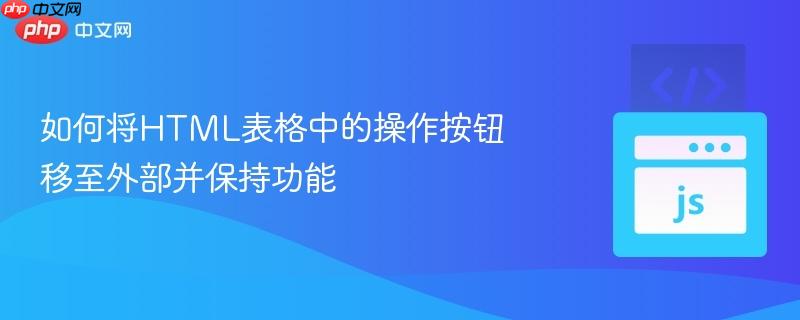
本教程旨在解决将HTML表格内部的操作按钮(如“添加”按钮)移至表格外部时,如何保持其原有功能的挑战。文章将详细阐述HTML结构调整、JavaScript代码适配的关键步骤,并提供相应的代码示例,确保按钮在脱离表格结构后仍能准确地与表格数据进行交互,同时优化用户界面布局。
在网页开发中,我们经常需要在HTML表格中集成操作按钮,例如用于添加新行、编辑或删除特定数据。最初,为了方便操作和简化DOM遍历,这些按钮可能被直接放置在表格的单元格(<td>)中。然而,出于界面设计、用户体验或功能分离的考虑,我们可能需要将这些操作按钮移至表格的下方或侧边,使其脱离表格的直接结构。本文将指导您如何安全有效地完成这一迁移,确保按钮功能不受影响。
当一个操作按钮直接位于表格的<td>元素内时,其JavaScript事件处理函数通常可以非常方便地通过this关键字(指向按钮本身)来访问其父元素(<td>),进而访问到祖父元素(<tr>)和更上层的表格结构。
考虑以下原始HTML结构示例:
立即学习“前端免费学习笔记(深入)”;
<html>
<head>
<style>
.center {
margin-left: auto;
margin-right: auto;
border-collapse: collapse;
width: 80%;
}
.center th, .center td {
border: 1px solid black;
padding: 8px;
text-align: left;
}
.center input[type="text"] {
width: 100%;
box-sizing: border-box;
border: none;
padding: 0;
margin: 0;
}
.btnAdd {
padding: 5px 10px;
cursor: pointer;
}
</style>
</head>
<body>
<h3 style="text-align:center">Schedule</h3>
<table id="editableTable" class="center">
<thead>
<tr>
<th>Name:</th>
<th>Surname:</th>
<th>Telephone:</th>
<th>Address:</th>
</tr>
</thead>
<tbody>
<tr>
<td><input type="text"></td>
<td><input type="text"></td>
<td><input type="text"></td>
<td><input type="text"></td>
<td><button class="btnAdd" onclick="moveToSeparateTable(this)">Add</button></td>
</tr>
</tbody>
</table>
</body>
</html>在这个例子中,Add按钮位于一个<td>中,并且onclick事件调用了moveToSeparateTable(this)。在JavaScript函数中,this将指向这个按钮,使得通过this.parentNode(<td>)和this.parentNode.parentNode(<tr>)来获取当前行的数据变得非常直接。
然而,将按钮置于表格内部有时会影响表格的布局,尤其是在响应式设计中,或者当您希望将所有主要操作按钮集中管理时。
要将按钮移至表格外部,最直接的方法是将其放置在表格元素之后,通常包裹在一个div容器中,以便于样式控制。
以下是修改后的HTML结构示例:
<html>
<head>
<style>
.center {
margin-left: auto;
margin-right: auto;
border-collapse: collapse;
width: 80%;
}
.center th, .center td {
border: 1px solid black;
padding: 8px;
text-align: left;
}
.center input[type="text"] {
width: 100%;
box-sizing: border-box;
border: none;
padding: 0;
margin: 0;
}
.btnAdd {
padding: 5px 10px;
cursor: pointer;
}
.table-actions {
text-align: center; /* 居中按钮 */
margin-top: 15px; /* 与表格保持一定距离 */
}
</style>
</head>
<body>
<h3 style="text-align:center">Schedule</h3>
<table id="editableTable" class="center">
<thead>
<tr>
<th>Name:</th>
<th>Surname:</th>
<th>Telephone:</th>
<th>Address:</th>
</tr>
</thead>
<tbody>
<tr>
<td><input type="text" id="nameInput"></td>
<td><input type="text" id="surnameInput"></td>
<td><input type="text" id="telephoneInput"></td>
<td><input type="text" id="addressInput"></td>
</tr>
<!-- 更多行可以在这里添加 -->
</tbody>
</table>
<div class="table-actions">
<button class="btnAdd" onclick="moveToSeparateTable()">Add New Entry</button>
</div>
</body>
</html>在这个新的结构中,Add New Entry按钮被放置在一个名为table-actions的div中,位于editableTable的下方。请注意,onclick事件现在不再传递this,因为按钮不再需要依赖其在表格内的上下文来查找相关数据。
当按钮从表格内部移出后,原有的JavaScript函数如果依赖this来获取表格行或单元格的上下文,将不再有效。我们需要修改JavaScript函数,使其能够独立地定位到它需要操作的表格元素。
假设moveToSeparateTable函数的目标是获取表格中当前输入框的数据,并可能将其添加到另一个表格或处理。当按钮在外部时,它需要明确地通过ID或其他选择器来查找editableTable及其内部的输入框。
以下是一个适配后的JavaScript代码示例:
<script>
function moveToSeparateTable() {
// 1. 获取目标表格元素
const editableTable = document.getElementById('editableTable');
if (!editableTable) {
console.error('Table with ID "editableTable" not found.');
return;
}
// 2. 假设我们要获取表格中第一行(或特定行)输入框的数据
// 注意:如果表格有多行输入,您需要明确指定要获取哪一行的数据
// 这里我们以获取第一行输入框的数据为例,并假设这些输入框有ID
const nameInput = document.getElementById('nameInput');
const surnameInput = document.getElementById('surnameInput');
const telephoneInput = document.getElementById('telephoneInput');
const addressInput = document.getElementById('addressInput');
if (nameInput && surnameInput && telephoneInput && addressInput) {
const name = nameInput.value;
const surname = surnameInput.value;
const telephone = telephoneInput.value;
const address = addressInput.value;
console.log("Collected Data:", { name, surname, telephone, address });
// 示例:将这些数据添加到另一个表格(假设存在一个id为'targetTable'的表格)
// 或者执行其他业务逻辑,例如通过AJAX发送数据到后端
const targetTable = document.getElementById('targetTable');
if (targetTable) {
const newRow = targetTable.insertRow();
newRow.insertCell().textContent = name;
newRow.insertCell().textContent = surname;
newRow.insertCell().textContent = telephone;
newRow.insertCell().textContent = address;
console.log("Data added to targetTable.");
// 清空原始输入框以便输入新数据
nameInput.value = '';
surnameInput.value = '';
telephoneInput.value = '';
addressInput.value = '';
} else {
console.warn("Target table with ID 'targetTable' not found. Data processed but not added to a new table.");
}
} else {
console.warn("Could not find all required input elements by ID.");
// 如果按钮的目的是添加一个新空行到editableTable
// 可以修改逻辑如下:
addNewEmptyRow(editableTable);
}
}
// 辅助函数:向editableTable添加一个新空行
function addNewEmptyRow(tableElement) {
const tbody = tableElement.querySelector('tbody');
if (tbody) {
const newRow = tbody.insertRow();
newRow.insertCell().innerHTML = '<input type="text">';
newRow.insertCell().innerHTML = '<input type="text">';
newRow.insertCell().innerHTML = '<input type="text">';
newRow.insertCell().innerHTML = '<input type="text">';
console.log("New empty row added to editableTable.");
}
}
</script>关键修改点:
将按钮移至表格外部后,您可以使用CSS来精确控制其位置和外观。
在前面的HTML示例中,我们使用了.table-actions类来包裹按钮,并应用了以下CSS:
.table-actions {
text-align: center; /* 使按钮在其容器内居中 */
margin-top: 15px; /* 在表格下方留出一定的间距 */
}您可以根据需要调整margin-top来控制按钮与表格之间的垂直距离,使用text-align来控制按钮的水平位置(left, center, right),或者使用Flexbox/Grid布局来创建更复杂的布局。
关于原始答案中提到的display: none/block,这是一种用于动态显示或隐藏元素的CSS属性。它与按钮的位置分离是不同的概念。如果您的需求是根据某些条件(例如用户权限或特定操作状态)来切换按钮的可见性,那么display: none;和display: block;会非常有用,您可以通过JavaScript来动态切换这些样式。但这与将按钮从表格内部移至外部的初始布局需求是不同的。
将HTML表格中的操作按钮移至外部是一个常见的需求,它能有效提升页面布局的灵活性和用户体验。实现这一目标的关键在于:
遵循这些步骤和最佳实践,您将能够成功地将操作按钮从表格中分离出来,同时确保其功能完整无损。
以上就是如何将HTML表格中的操作按钮移至外部并保持功能的详细内容,更多请关注php中文网其它相关文章!

HTML怎么学习?HTML怎么入门?HTML在哪学?HTML怎么学才快?不用担心,这里为大家提供了HTML速学教程(入门课程),有需要的小伙伴保存下载就能学习啦!

Copyright 2014-2025 https://www.php.cn/ All Rights Reserved | php.cn | 湘ICP备2023035733号